Tran Quoc Pagoda is one of the most iconic and popular attractions in Hanoi. Located on a small peninsula on the eastern shore of West Lake (also known as Hồ Tây), the pagoda offers visitors beautiful architecture surrounded by tranquil scenery. With over 1,500 years of history, Tran Quoc Pagoda is the oldest pagoda in Hanoi and a must-see for any first-time visitor.
This guide will provide essential information on Tran Quoc Pagoda, including its history, architecture, visiting hours, entrance fees, popular activities, and nearby attractions and restaurants. Read on to plan your visit to this ancient Buddhist temple in Vietnam’s charming capital city.
Where is Tran Quoc Pagoda?
Tran Quoc Pagoda (known locally as Chùa Trấn Quốc) is located on a small peninsula jutting out into West Lake. The address is: No. 46, Thanh Nien Street, Quan Thanh Ward, Tay Ho District, Hanoi
The pagoda can be easily reached by taxi, bus, motorbike or bicycle. Some of the nearby bus routes that stop close to Tran Quoc Pagoda are bus number 33 and 50. Using a ride-sharing app like Grab is also very convenient.
Opening Hours and Entrance Fees
Tran Quoc Pagoda is open daily from 8 AM to 4 PM. Special opening hours apply for certain days:
- Lunar New Year’s Eve: Open all night for visitors
- 1st and 15th days of lunar months: Opens at 6 AM to 6 PM
- Entrance is free for all visitors
Note that the pagoda gets especially crowded during festival days and public holidays like the Lunar New Year (Tet).
Tran Quoc Pagoda History
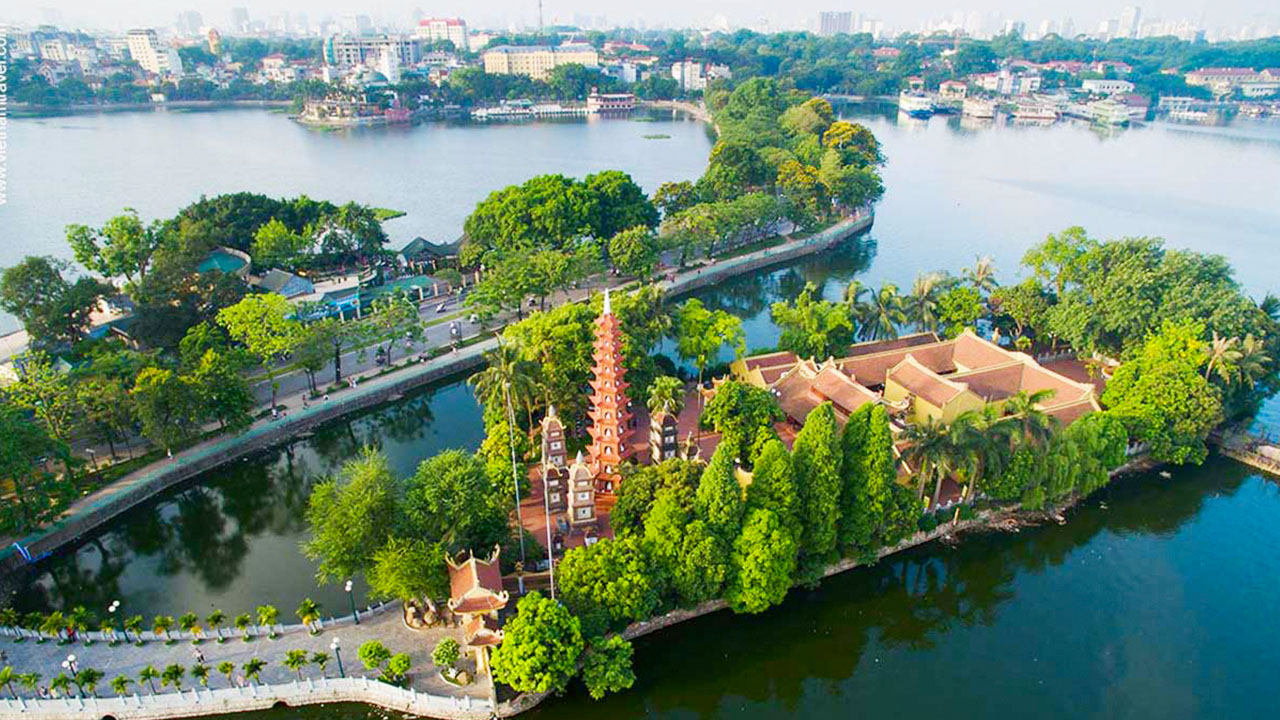
The Tran Quoc Pagoda was founded in the 6th century during the Early Ly Dynasty, making it the oldest pagoda in Hanoi. It was originally built in 541 AD and was first named Khai Quoc Pagoda.
In the 15th century, the pagoda was rebuilt and renamed Chùa Trấn Quốc (National Defense Pagoda) by the King Le Hy Tong to inspire patriotism during a period of Chinese invasions. Over the centuries, the pagoda has gone through several renovations while preserving its cultural essence.
Some of the pagoda’s historic treasures from antiquity have been preserved to this day, like steles and engraved boards from the 16th and 17th centuries. The pagoda serves as a repository of Buddhist cultural heritage and history for scholars and visitors alike.
Origins of Tran Quoc Pagoda
Tran Quoc Pagoda was first built in 541 AD by King Ly Nam De on the shores of West Lake, which was seen as the spiritual center of Hanoi. The king envisioned a symbol of national strength, hence naming it “Khai Quoc” Pagoda which translates to “Awakening the Country” Pagoda.
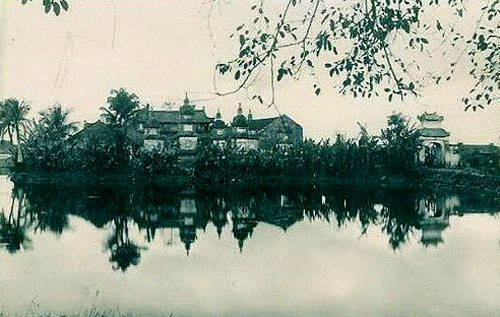
Legend has it that the location was chosen because many turtles rose from West Lake, auguring a prosperous location to build a Buddhist center of worship. Turtles hold special symbolism in Vietnamese culture, associated with longevity and fortune.
Renaming to Tran Quoc Pagoda
In the 15th century, the temple was in disrepair and was rebuilt from 1428 to 1430 by King Le Hy Tong, who renamed it to Tran Quoc (Protecting the Nation) Pagoda to inspire his people during a time of Chinese aggression. Tran Quoc Pagoda served as a center of Buddhist teaching and also symbolized Vietnam’s independent spirit despite foreign invasions.
The name Tran Quoc has been associated with the pagoda ever since, instilling national identity and connection to the motherland. When translated, Tran means “to stabilize”, and Quoc means “nation”, referencing the pagoda’s special status as a stabilizing force for the nation.
Tran Quoc Pagoda Architecture

Tran Quoc Pagoda represents a quintessential example of traditional Vietnamese Buddhist architecture and design. The pagoda covers an area of around 3,000 square meters.
Built of wood and other precious materials like gemstones and bronze, the architecture features simplicity yet excellent craftwork and attention to detail. Graceful sloping roofs layered like flower petals or waves curve upwards at the corners, accented with intricate patterns and rooftop decorations.
The 11-Storey Stupa (Bao Thap)
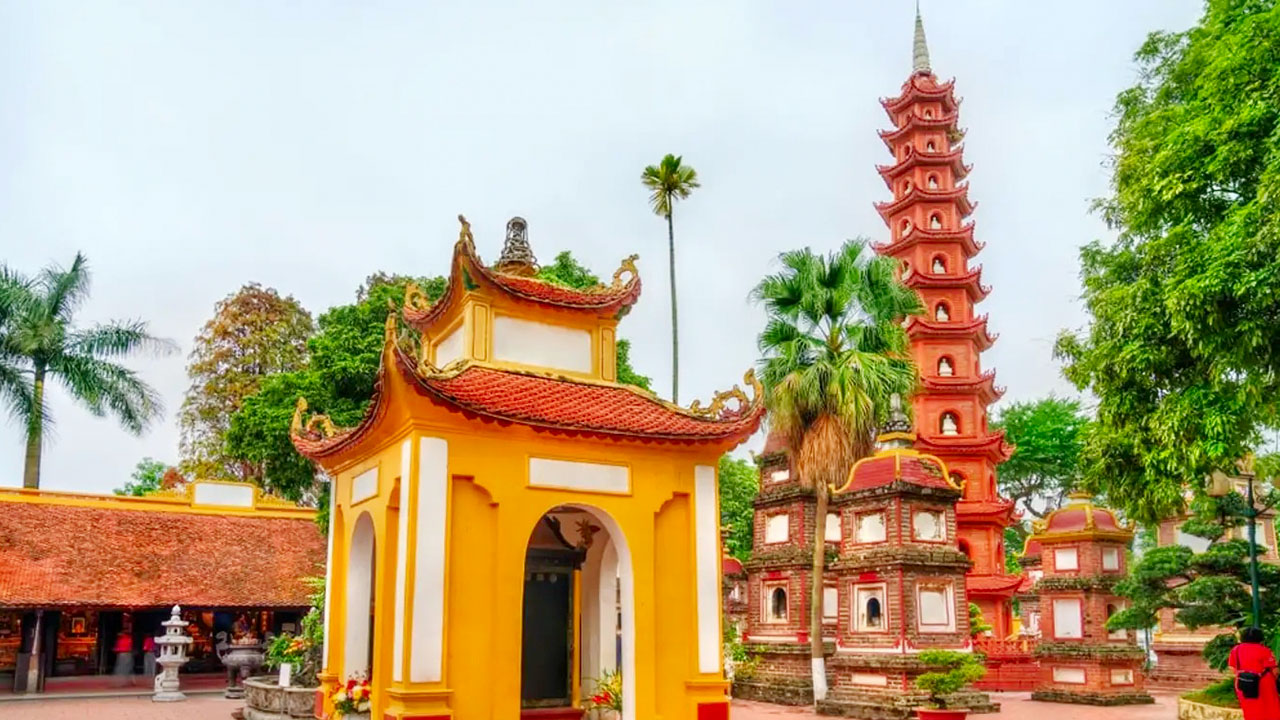
The 11-tiered stone Stupa of Tran Quoc Pagoda called Bao Thap is”,”completion”:” tallest in Vietnam, looming at an impressive height of over 15 meters.
The 11-Storeys represent a symbolic progression towards enlightenment, from the human realm at the bottom to the highest realms of spiritual awakening. As visitors circumambulate around the Stupa in prayer, they walk past stone carved statues of Buddha.
Statues and Reliefs
The body of the Stupa features 98 bas-relief carvings of images that tell stories from the Buddha’s past lives called “Jataka tales”. Other carvings depict scenes like the Buddha returning to his Palace after achieving enlightenment as monks bow and pay respect.
Four white gemstone statues of Buddha are seated at the Stupa’s base facing north, south, east and west. These portray Amitabha, the celestial Buddha of Infinite Light, expressing boundless wisdom and compassion.
The Front House (Tien Duong)
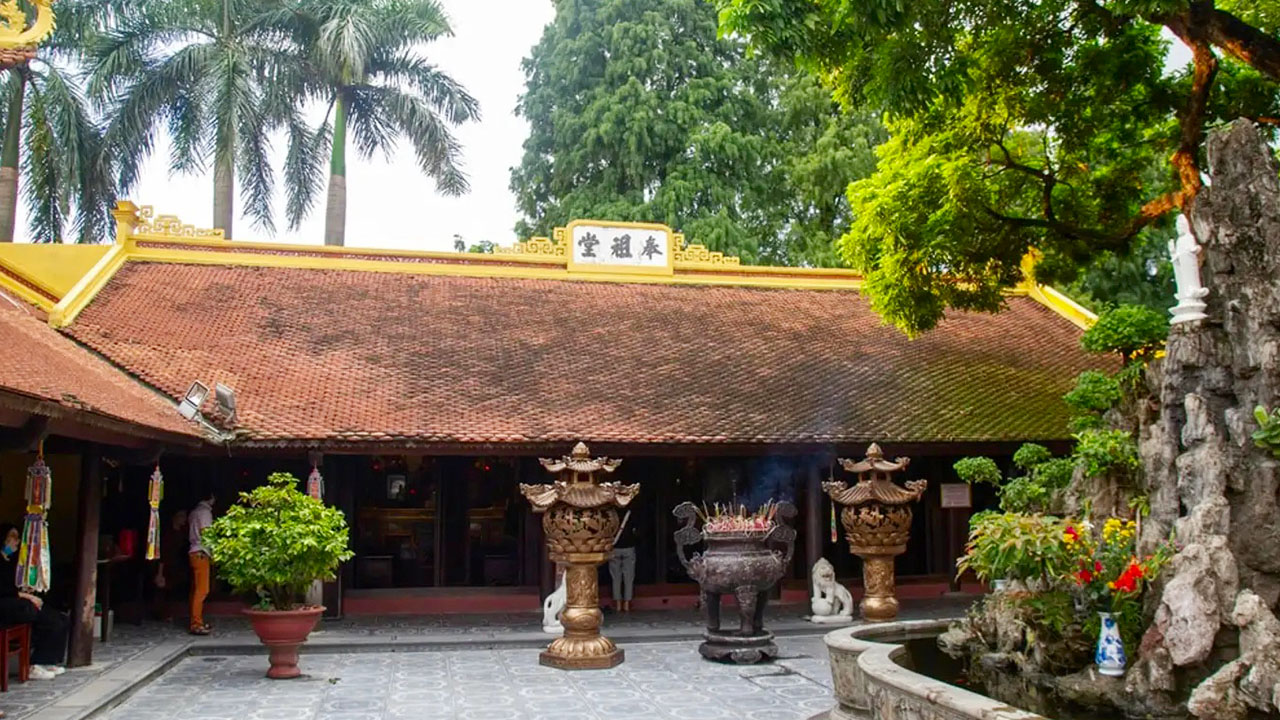
After entering the triple-doored gate into the Front House, visitors will find a bronze bell and large drum for prayers. At the center of the hall sits an impressive statue of Shakyamuni Buddha with nine dragons climbing on his reclining body. The statue, materials and architecture are all culturally influenced from China.
Voted as Vietnam’s most beautiful statue depicting the Reclining Buddha’s death and passage into Nirvana, the details are intricate down to each thin wrinkle and curved fingernail. The Shakyamuni Buddha statue is 6 meters long, expressing a serene state of peace.
The Incense Burning House (Nha Thieu Huong)
Behind the Front House stands the Incense Burning House with ornamental roof layers that create an octagonal design. Within you’ll find a cauldron filled with incense sticks where pilgrims pray and make offerings, wisps of scented smoke spiraling up into the rafters. This area sees the most visitors coming to practice their faith and make wishes.
Wishing Pond
Next to the Incense Burning House lies the Vow Pond filled with blooming pink lotus blossoms where visitors toss coins and pray for health, luck and prosperity. The sound of coins clinking into the water joins the murmur of quiet mantras being chanted.
The Upper House (Thuong Dien)

The Thuong Dien is the Upper Main Hall where the most significant rituals and religious events are held, like ordination and prayer ceremonies. This impressively wide hall contains three gold-covered statues of Amitabha Buddha with two assistants at his sides along with other Bodhisattva statues like Manjushri and Samantabhadra.
During special pagoda anniversaries and celebrations like Vesak Day (Buddha’s birthday), this hall hosts cultural activities like Buddhist dance and musical performances.
The Stele House (Nha Bia)
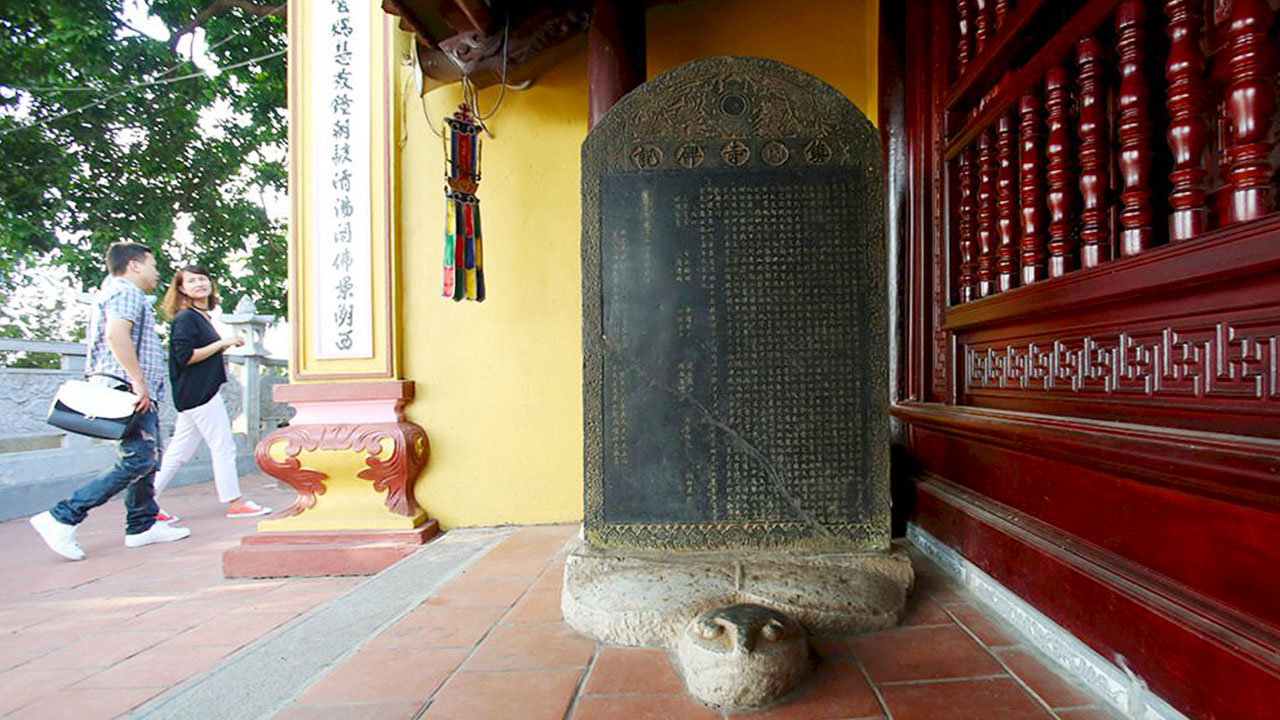
Nha Bia contains a precious collection of over 20 stone steles inscribed with Chinese and Demotic script documenting records about the pagoda’s history, repairs, donations and cultural heritage. Many steles date back to the Le Dynasty during King Le Hy Tong’s reign in the 15th century. The Nha Bia thus serves as the pagoda’s historical archive, letting people discover facts about Tran Quoc Pagoda’s past.
Tran Quoc Pagoda Reviews
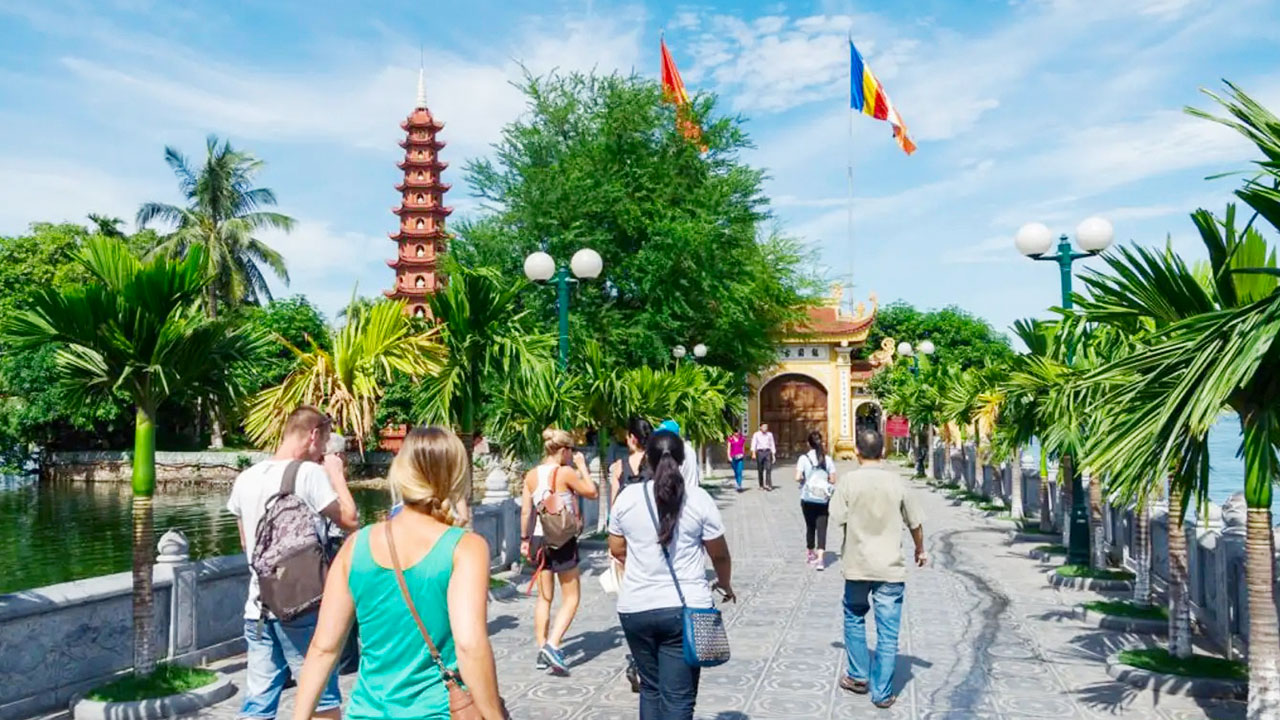
With its rich history spanning over 15 centuries, alluring architecture and serene lakeside setting, it’s no wonder Tran Quoc Pagoda has become an iconic must-visit Hanoi attraction.
Millions of tourists each year leave glowing reviews. Visitors are enchanted by the intricate red lacquer pillars, bronze bells and ancient artifacts housed within the ancient temple. The natural scenic beauty surrounding Tran Quoc pagoda also amazes people, who love photographing the misty lake and marveling at magical sunrises over the water.
Pilgrims and monks review Tran Quoc Pagoda as a profoundly sacred place of worship infused with a deep sense of spirituality and peaceful atmosphere perfect for prayer and contemplation. Whether religious or not, taking a moment to soak in the tranquility by listening to the quiet lapping of waves along the shores of West Lake is popular.
Attractions Near Tran Quoc Pagoda
Tran Quoc Pagoda‘s excellent lakeside location places it within walking distance of other top attractions around West Lake, ideal to combine together in one day:
Quan Thanh Temple: Also located on a small peninsula on West Lake, the 11th century Taoist Quan Thanh Temple dedicated to Tran Vo Bac Deity provides a lovely complementary cultural experience to balance the Buddhist Tran Quoc Pagoda. Visitors can admire the temple’s bronze statues, try unique Vietnamese fortune telling rituals and enjoy the scenic views by boat on the lake.

West Lake Hanoi: West Lake is a beloved recreational spot for both residents and visitors alike. Guests can partake in activities such as boat rentals, indulging in delicious meals at charming lakeside cafes, exploring ancient pagodas, or simply basking in the breathtaking vistas of the serene water.
Ho Chi Minh Mausoleum: This grand structure houses the well-preserved body of Vietnam’s renowned leader, Ho Chi Minh, who led the country to freedom and held the position of president until his passing in 1969. The mausoleum, made of granite, is inspired by the design of Lenin’s tomb in Moscow.
Bat Trang Ceramic Village: Just a 10 minute taxi ride away lies the charming Bat Trang Village renowned for its signature pottery and porcelain. After visiting Tran Quoc Pagoda, experiencing how Bat Trang artisans handcraft fine ceramic wares using techniques from the 14th century makes for a great cultural day.
Places to Eat Near Tran Quoc Pagoda
When hungry after exploring the sights, visitors have diverse dining options from casual lakeside cafes to fine-dining Vietnamese restaurants near Tran Quoc Pagoda featuring delicious cuisine with a view.
Sen Ho Tay buffet restaurant: When searching for dining options at West Lake, one cannot miss the Sen West Lake Buffet Restaurant. With its prominent location and renowned reputation for delicious Hanoi cuisine, this restaurant entices diners with a perfect blend of delectable flavors and elegant ambiance, showcasing the essence of Vietnam.
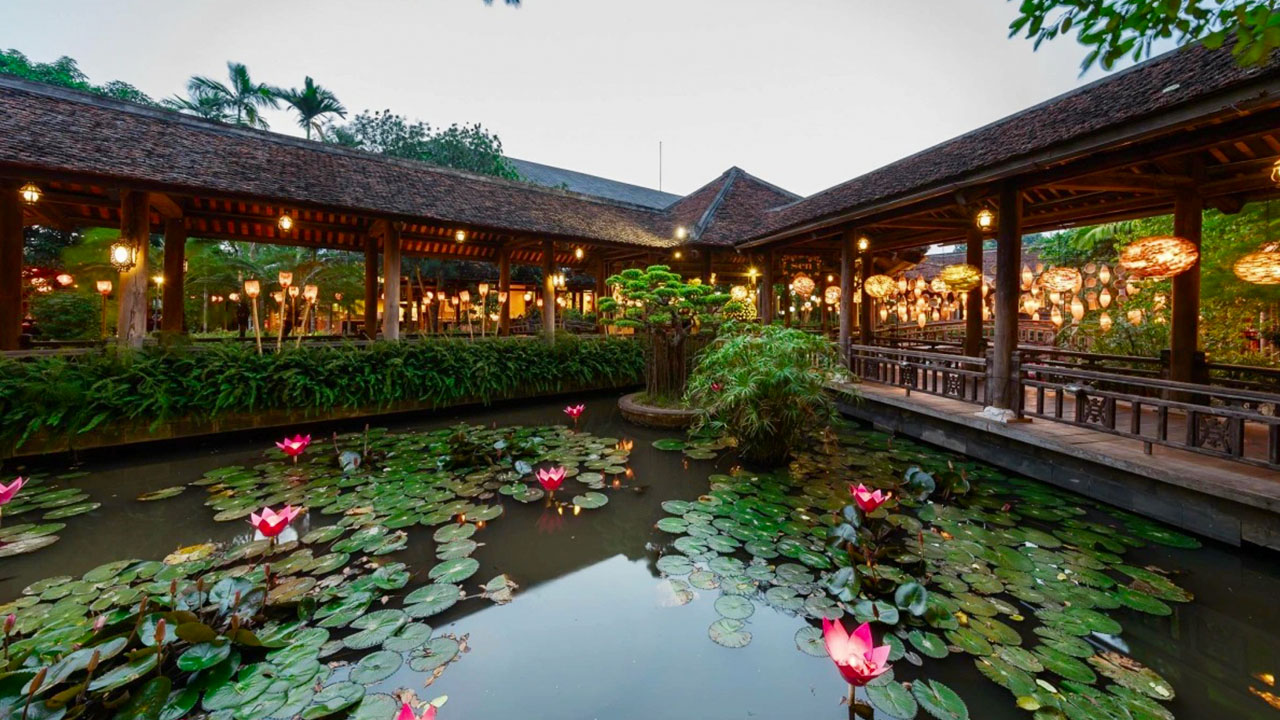
The menu at Sen West Lake Restaurant offers a diverse selection, ranging from traditional and flavorful Vietnamese dishes to exquisite Western delicacies. Moreover, their fresh seafood buffet and unique dessert options are particularly alluring to diners.
Ho Tay shrimp cake restaurant with view of Tran Quoc pagoda: The Hồ Tây shrimp cake restaurant is a perfect destination for those who love this dish in Hanoi. With its cool location, wide and dreamy view, you can enjoy the peaceful atmosphere and beautiful scenery of Hồ Tây in the evening while indulging in crispy and fragrant golden fried shrimp cakes. The perfect combination of sweet and sour sauce, stir-fried vegetables and fresh herbs gives the dish a rich and spicy flavor without being overwhelming.
In addition to the Hồ Tây shrimp cake, the restaurant also serves many other delicious dishes such as spring rolls, crab, clams, hot pot, swallow’s nest porridge, rice, and Italian pasta…
West Lake Ice Cream on Thanh Nien Street: This ice cream shop is located on Thanh Nien street, between Truc Bach lake and West lake, near Tran Quoc pagoda. The space of the shop is quite airy, spacious, and breezy with a direct view of West Lake. With over 40 years in operation, it is one of the four oldest places to enjoy ice cream in Hanoi. Compared to Trang Tien ice cream, the flavors here are less sweet. Despite not having a wide variety, every flavor of ice cream is delicious, leaving customers completely enamored.
Conclusion
With its fascinating history, serene spiritual atmosphere and proximity to top attractions around West Lake, Tran Quoc Pagoda offers visitors to Hanoi a profound experience combining culture, natural beauty and heritage spanning over a millennium.
Use our guide detailing everything you need for a rewarding visit from directions, fees and reviews to nearby sights and restaurants, for an unforgettable experience at Hanoi’s oldest pagoda, the magnificent Tran Quoc Pagoda.


